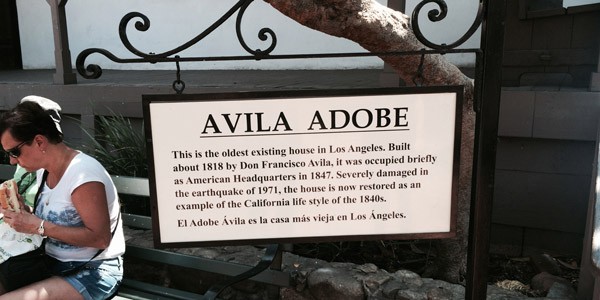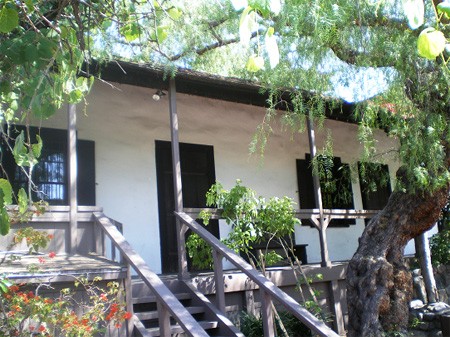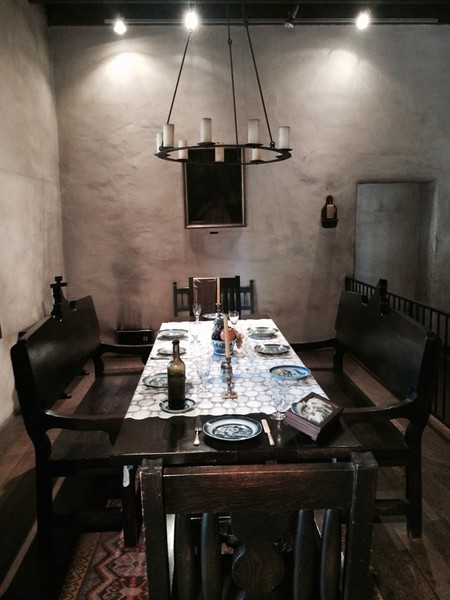Avila Adobe
Introduction
Text-to-speech Audio
Avila Adobe is believed to be the oldest surviving residence in Los Angeles. The structure was built in 1818 by the mayor of Los Angeles, Francisco Jose Avila. The area was part of Mexico at that time, and the mayor, like nearly all others in the area, where either citizens of Mexico or members of Native American tribes. Today, the home is located in the paseo of historical Olvera Street within the Plaza Historic District- a California State Historic Park.
Images
Avila Adobe is registered as California Historical Landmark #145. It is part of the Los Angeles Plaza historic district, listed on the National Register of Historic Places.

Avila Adobe is open to the public as a museum and is furnished as it might have appeared in the late 1840s.

The Visitors' Center offers gifts, books, maps, postcards, mementos and other items for sale that reflect El Pueblo's rich history.

Backstory and Context
Text-to-speech Audio
The Avila Adobe was built in 1818 by Francisco José Avila, a native of Sinaloa, Mexico who was a famous and affluent ranchero, or cattle rancher. He was also the mayor of Los Angeles from the years 1810-1811. In 1823, the Mexican government granted Francisco Avila a large 4,439-acre land grant which covered much of present-day Beverly Hills and the Miracle Mile district. This land was called Rancho Las Cienegas, near La Brea Pits, approximately seven miles west of the pueblo.
Although the house was renovated in 1929 to prevent the state of California from tearing it down, the Avila Adobe still has the look and feel of early 19th century Californio, when Mexico owned present-day California. The Adobe Avila is immaculately built of tar from the La Brea Tar Pits, clay from the LA River and wood from the riverbank. This beautiful historic home features 3-foot-thick walls made of sun baked adobe brick over cottonwood timbers, a traditional interior courtyard, and 1840s-era furnishings that bring to life an era when the city was still part of Mexico. The ceilings, which are still the original, are fifteen feet high with support beams made from cottonwood. The floor of the building was originally hard-as-concrete compacted earth. This concrete replica was swept several times a day to keep the surface smooth. It was later covered with varnished wood planks.
Today the Avila has seven rooms left. The largest room in the home is the family room which was used for dining, entertaining and social gatherings. The 'sala' or living room was only used for special occasions such as weddings or baptisms. Other areas of the adobe include a large courtyard with covered porches, stables and workshops.
Following Francisco Avila's death in 1832, his second wife, Encarnación Avila, continued to live in the house with her two daughters. From January 10-19, 1847, the Avila Adobe was captured and used as a military headquarters by the invading North American army under Robert Stockton in the Mexican-American War. After Encarnación Avila died in 1855, the home passed to her two daughters, Luisa and Francisca and their husbands, Manuel Garfias and Theodore Rimpau. Francisca and Theodore Rimpau and their nine children continued to live in the adobe from 1855 to 1868. From 1868 to the early 1920s, the adobe was rented and used as a restaurant, rooming house for transients, or was often vacant. The Avila Adobe's condition slowly worsened and was finally condemned in 1926 by the City Health Department, which caught the attention of Christine Sterling, who began a public campaign to save the adobe. After a few short years of trying to find funds to restore the house, Sterling was able to find the funds to restore the house after a few short years thanks to awareness brought forth from LA Times owner Harry Chandler.
Sources
"The Avila Adobe." City of Los Angeles. Accessed June 22, 2016. http://elpueblo.lacity.org/SightsSounds/HistoricStructures/TheAvilaAdobe/index.htm Link, Sarah. "Making History: Avila Adobe, LA’s oldest home." Dunn-Edwards. August 17, 2014. https://www.dunnedwards.com/colors/specs/posts/making-history-avila-adobe-las-oldest-home Nelson, Lee. "Historic Olvera Street in Los Angeles." ineTours. Accessed June 22, 2016. http://www.inetours.com/Los_Angeles/Pages/Olvera_St.html.
